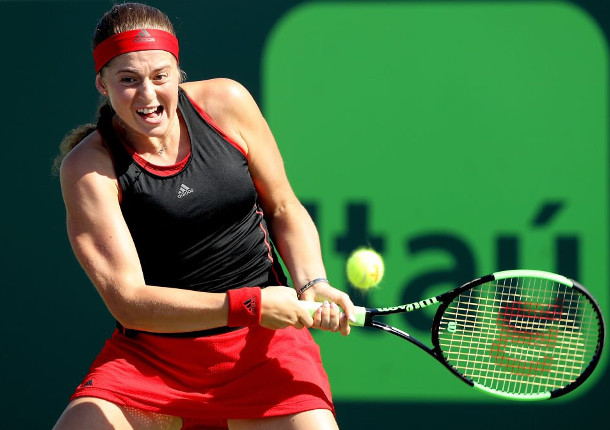By Richard Pagliaro | Friday, March 30, 2018
Sloane Stephens carries a 5-0 record in career finals into the Miami Open championship match.
Photo credit: Miami Open
The final Miami Open final staged on Key Biscayne will be a battle of territorial tennis between Grand Slam champions.
Reigning Roland Garros champion Jelena Ostapenko squares off with US Open champion Sloane Stephens for the first time in Saturday’s final featuring a pair of superb shotmakers, who have grown sharper as the sun sets on the farewell to tennis paradise. Key Biscayne’s Crandon Park.
Next year, the Miami Open moves about 20 miles north to the Hard Rock Stadium home of the Miami Dolphins.
Both finalists have NFL connections.
Stephens’ father, the late John Stephens, was a Pro Bowl player for the New England Patriots.
Ostapenko hits harder than J.J. Watt.

On the surface, this final pits Ostapenko’s ballistic shotmaking against Stephens’ balanced court coverage and consistency.
Ultimately, it could come down to court positioning.
The 20-year-old Ostapenko has shown a Monica Seles-like ability to play bigger and bolder beneath the burdens of tiebreak stress. Ostapenko has won all five tie break sets she’s played in the tournament sweeping two-time Wimbledon champion Petra Kvitova, fourth-ranked Elina Svitolina and American qualifier Danielle Collins to reach her first final of the season.
The 13th-seeded Stephens has knocked off three Grand Slam champions in succession—Garbine Muguruza, Angelique Kerber and Victoria Azarenka—showing sharp transition skills. Stephens has defended when she’s needed to, dictated with her forehand at times and shown a willingness to move forward into the court.
Both women have acted on timely tactical advice from their coaches—Kamau Murray coaches Stephens and veteran David Taylor coaches Ostapenko—and adjustments could come into play if the final goes the distance.
Ostapenko has more clarity, Stephens owns more variety.
Ostapenko will want to blow Stephens back off the baseline with pace, while Stephens will try to use shifting spins and sharp angles to displace the French Open champion from the baseline.
Our Miami Open final preview.
No. 5 Jelena Ostapenko (LAT) vs. No. 12 Sloane Stephens (USA)
Head-to-head: First meeting
2018 Record: Ostapenko 9-7; Stephens 8-4
Career Titles: Ostapenko 2; Stephens 5
Career Three-Set Record: Ostapenko 29-20; Stephens 55-37
Jelena Ostapenko on Miami success: "I think maybe the other tournaments I was trying to, like, play more balls in the court and without any aggressivity. But now I think I really go for the shot when I need to and I'm not afraid to risk."
Sloane Stephens on Miami success: "Here and there there is going to be things that you can't control whatsoever and you've just got to go with it. Sometimes it's not a bad thing because you kind of push yourself to places that you really would not normally go if, like, the conditions were perfect and we were both playing great and whatever. I have just kind of learned to embrace it, because totally out of my control."
Why Ostapenko Will Win
Controlling the center of the court, the hard-hitting Latvian can push even elite players to defend the edges. Ostapenko fired 44 winners in her quarterfinal win over fourth-ranked Elina Svitolina, one of the best defenders on tour.
When she’s on, Ostapenko’s down the line drives are among the damaging weapons in the game. Ostapenko is the more proactive player willing to take the first strike who can dictate rallies. Look for the 20-year-old Latvian to use her kick serve to back the 5’7” American up, then try to control exchanges with an aggressive strike.
Stephens is one of the speediest players in the sport, but Ostapenko is very accurate hitting behind opponents and can bang her backhand crosscourt with such pace and angle she will force Stephens into defending with the one-handed slice. Ostapenko is at her best crunching heavy groundstrokes while straddling the baseline and her backhand may be the biggest shot on the court. If she’s taking the ball on the rise and timing her vicious strokes, Ostapenko should be in charge of baseline rallies.
Why Stephens Will Win
Tennis is a game of motion and Stephens is one of the sport’s smoothest movers. Speed around the court and taking short preparation steps are essential elements amid the swirl of Key Biscayne, one of the tour’s windiest events, and the fact Stephens grew up in Florida gives her adaptability amid unruly conditions.
Stephens owns more variety, serves bigger, defends better and she’s already defeated Grand Slam champions Victoria Azarenka and Garbine Muguruza, who play similar aggressive baseline game to Ostapenko predicated on the point-ending down the line dagger.
While it’s true Stephen’s went on walkabout about looked apathetic at times during her eight-match losing streak that followed her Flushing Meadows triumph, it’s equally true Stephens often brings her best in the biggest moments. Stephens is 5-0 in WTA finals, including three titles on American soil, and should be pumped playing before supportive home fans.
Prediction
Two exceptionally-talented Grand Slam champions have completely different approaches to point construction. Ostapenko will unleash declarative drives to detonate points, Stephens will vary her spins and angles to try to drag the Latvian wide and extend points.
Ultimately, Stephens has more gears to her game, she can transition from defense to offense and knows how to close at net. If Ostapenko is timing her roundhouse strokes with the precision, she can hit her way to the biggest hard-court title of her career.
Stephens has defused three Grand Slam champions en route to the final and if she stays calm and drives the ball with depth she should prevail in front of home fans.
The Pick
Sloane Stephens d. Jelena Ostapenko in three sets.